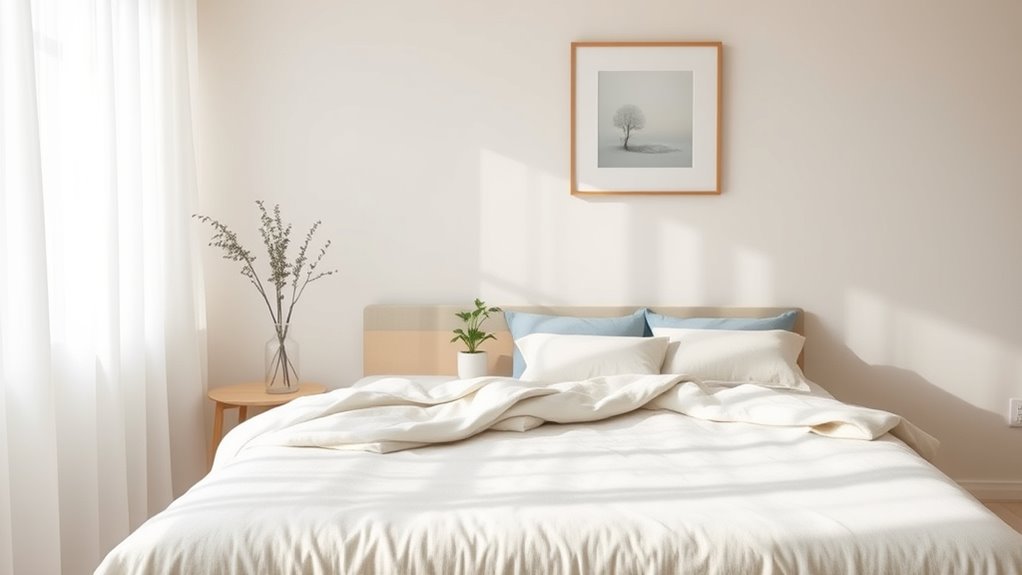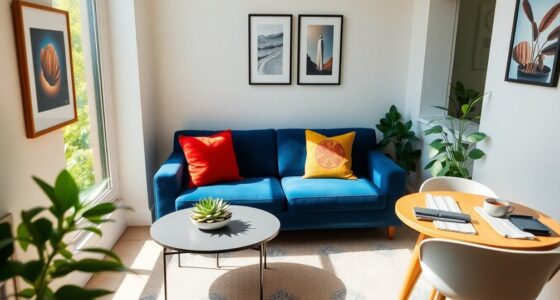To create a serene bedroom layout, position your bed in the feng shui Command Position—away from windows and doors but still facing the door for good energy flow. Incorporate soft, neutral colors and layered lighting with dimmable options to promote calmness. Use natural elements like wood and gentle textures, and keep clutter to a minimum to foster harmony. If you keep these tips in mind, you’ll discover how to craft a restful and balanced space that supports relaxation.
Key Takeaways
- Arrange the bed to face the doorway without direct alignment, promoting a sense of safety and flow.
- Use soft, neutral colors and layered lighting to create a calming, clutter-free environment conducive to relaxation.
- Incorporate natural materials and textures to enhance warmth and tactile comfort while maintaining harmony.
- Maximize natural light with airy window treatments and avoid harsh or overly bright lighting for a soothing atmosphere.
- Keep the space minimal with simple decor, ensuring a balanced, peaceful layout that fosters restful sleep.

A serene bedroom layout begins with thoughtful planning and intentional design choices that promote relaxation. One of the most impactful aspects of creating a calming space is paying attention to lighting placement. You want to guarantee that the lighting isn’t harsh or overly bright, which can disrupt your peace of mind. Instead, opt for layered lighting—soft ambient lights combined with task lighting for reading or other activities. Position bedside lamps or wall sconces at a height that avoids glare and creates a gentle glow, fostering a cozy atmosphere. Consider adjustable dimmers so you can tailor the light level based on your mood or time of day. Natural light also plays a crucial role; keep window treatments light and airy, allowing sunlight to filter in without overwhelming the room. During the day, open curtains to flood the space with natural brightness, and at night, switch to softer, warmer tones to wind down. Incorporating layered lighting enhances the room’s serenity by allowing flexibility in mood and ambiance. Color schemes are equally essential in establishing a serene environment. When selecting colors, aim for hues that evoke tranquility and comfort. Soft neutrals like beige, taupe, or warm greys create a neutral backdrop that promotes relaxation. Pastel shades—light blues, gentle greens, or muted lavenders—can add a subtle touch of color without overwhelming the senses. These colors help foster a sense of calm and can even influence your mood positively. Avoid bold, saturated hues that may energize or distract you before sleep. Instead, choose a cohesive palette that flows seamlessly, making the space feel harmonious. Incorporate these colors through wall paint, bedding, curtains, and decorative accents to create a unified look. Keep in mind that contrast should be minimal; instead, aim for smooth transitions between shades to maintain a peaceful vibe. Pairing thoughtful lighting placement with soothing color schemes sets the foundation for a restful retreat. When these elements work together, they enhance each other’s calming effects. For example, soft lighting in a room painted in muted tones amplifies the sense of serenity. Keep accessories and furniture simple and uncluttered, as visual clutter can disrupt your tranquility. Incorporate natural textures—like wood, linen, or wool—to add warmth and tactile comfort. Remember, the goal is to cultivate an environment where you feel safe, relaxed, and at ease, making every night a restorative experience. By consciously choosing your lighting and colors, you take a significant step toward creating a bedroom that truly nurtures your well-being.
Frequently Asked Questions
How Can I Incorporate Natural Elements Into My Bedroom Design?
You can incorporate natural elements into your bedroom by adding indoor plants, which bring fresh energy and improve air quality. Use natural materials like wood, stone, or bamboo for furniture, decor, and accents to create a calming, earthy vibe. Incorporate soft textiles made from organic fibers, and choose natural light sources whenever possible. These elements help foster a peaceful environment, aligning with your desire for a serene, balanced space.
What Colors Promote Relaxation and Tranquility in a Bedroom?
Imagine walking into a sanctuary where every hue whispers peace. You should choose calming hues like soft blues, gentle greens, and warm neutrals, as color psychology proves these shades promote relaxation and tranquility. These colors help reduce stress and create a soothing atmosphere. Incorporate them into your bedding, walls, and decor to craft a serene space that invites restful sleep and rejuvenation every night.
How Should I Arrange Furniture for Optimal Airflow and Energy Flow?
You should place your bed so it’s not directly aligned with the window, allowing for better airflow and energy flow. Position the bed with a solid headboard against a wall that’s free of windows, which provides stability and safety. Avoid placing furniture in a way that blocks natural light or airflow from windows. This arrangement promotes a calm, balanced environment, enhancing positive energy and creating a more restful space.
Are There Specific Symbols or Decor Items That Enhance Feng Shui?
Honestly, who doesn’t want their bedroom to sparkle with mystical power? You should include symbolic decor and auspicious symbols like dragons, phoenixes, or crystals—they supposedly attract positive energy. Just imagine your bed surrounded by items that scream ‘good vibes only.’ These symbols reinforce harmony and balance, turning your space into a sanctuary where energy flows freely—until your cat decides to redecorate with a stolen sock.
How Can I Reduce Electromagnetic Interference in My Bedroom?
To reduce electromagnetic interference in your bedroom, start by incorporating electromagnetic shielding around your devices and outlets. Create tech-free zones, especially near your bed, to minimize exposure. Unplug electronics when not in use and consider using grounding mats or filters to block EMFs. Keeping electronic devices away from your sleeping area helps promote better sleep and a more peaceful environment, aligning with feng shui principles for serenity.
Conclusion
By blending feng shui principles with modern tips, you craft a bedroom that feels like a calming sanctuary—a peaceful oasis where clutter clears like a storm passing through. As you arrange your space with intention, each element becomes a brushstroke in a tranquil masterpiece. Remember, your bedroom is your haven; nurture it, and it’ll nurture your soul in return, transforming your nightly retreat into a sanctuary of serenity and renewal.









